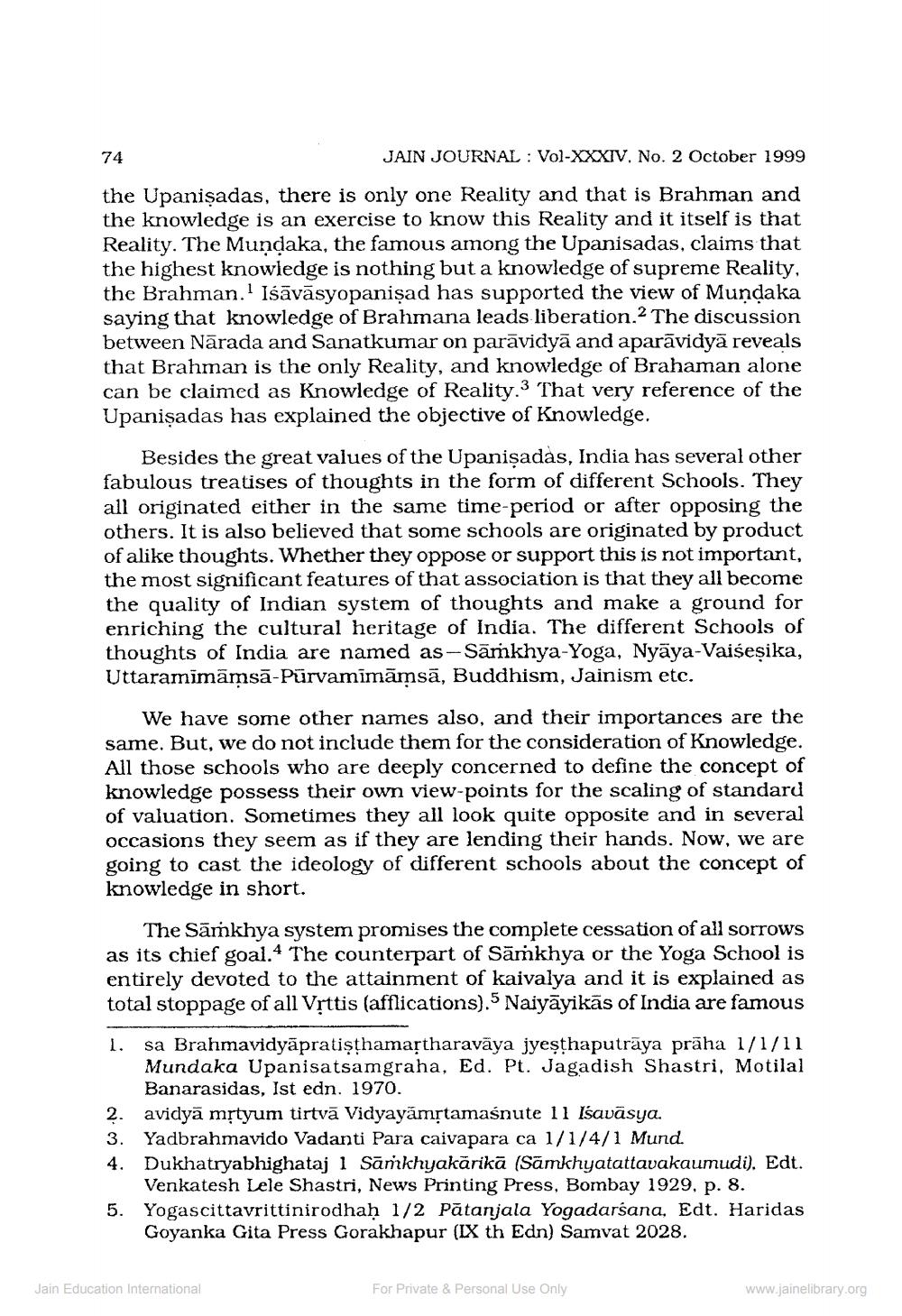Book Title: Jain Journal 1999 10 Author(s): Jain Bhawan Publication Publisher: Jain Bhawan Publication View full book textPage 7
________________ JAIN JOURNAL: Vol-XXXIV. No. 2 October 1999 the Upanisadas, there is only one Reality and that is Brahman and the knowledge is an exercise to know this Reality and it itself is that Reality. The Mundaka, the famous among the Upanisadas, claims that the highest knowledge is nothing but a knowledge of supreme Reality, the Brahman.1 Iśāvāsyopaniṣad has supported the view of Mundaka saying that knowledge of Brahmana leads liberation.2 The discussion between Narada and Sanatkumar on parāvidya and aparāvidya reveals that Brahman is the only Reality, and knowledge of Brahaman alone can be claimed as Knowledge of Reality.3 That very reference of the Upanisadas has explained the objective of Knowledge. 74 Besides the great values of the Upanisadas, India has several other fabulous treatises of thoughts in the form of different Schools. They all originated either in the same time-period or after opposing the others. It is also believed that some schools are originated by product of alike thoughts. Whether they oppose or support this is not important, the most significant features of that association is that they all become the quality of Indian system of thoughts and make a ground for enriching the cultural heritage of India. The different Schools of thoughts of India are named as-Samkhya-Yoga, Nyaya-Vaiseṣika, Uttaramīmāmsā-Purvamīmāmsā, Buddhism, Jainism etc. We have some other names also, and their importances are the same. But, we do not include them for the consideration of Knowledge. All those schools who are deeply concerned to define the concept of knowledge possess their own view-points for the scaling of standard of valuation. Sometimes they all look quite opposite and in several occasions they seem as if they are lending their hands. Now, we are going to cast the ideology of different schools about the concept of knowledge in short. The Samkhya system promises the complete cessation of all sorrows as its chief goal.4 The counterpart of Samkhya or the Yoga School is entirely devoted to the attainment of kaivalya and it is explained as total stoppage of all Vrttis (afflications).5 Naiyayikās of India are famous 1. sa Brahmavidyapratisthamaṛtharavaya jyeṣṭhaputrāya praha 1/1/11 Mundaka Upanisatsamgraha, Ed. Pt. Jagadish Shastri, Motilal Banarasidas, Ist edn. 1970. 2. avidya mṛtyum tirtva Vidyayamṛtamasnute 11 Isavāsya. 3. Yadbrahmavido Vadanti Para caivapara ca 1/1/4/1 Mund. 4. Dukhatryabhighataj 1 Saṁkhyakārikā (Samkhyatattavakaumudi). Edt. Venkatesh Lele Shastri, News Printing Press, Bombay 1929, p. 8. 5. Yogascittavrittinirodhaḥ 1/2 Patanjala Yogadarsana, Edt. Haridas Goyanka Gita Press Gorakhapur (IX th Edn) Samvat 2028. Jain Education International For Private & Personal Use Only www.jainelibrary.orgPage Navigation
1 ... 5 6 7 8 9 10 11 12 13 14 15 16 17 18 19 20 21 22 23 24 25 26 27 28 29 30 31 32 33 34 35 36 37 38 39 40 41 42 43 44 45 46 47 48 49 50 51 52 53 54 55 56 57 58 59 60 61 62 63 64 65 66
